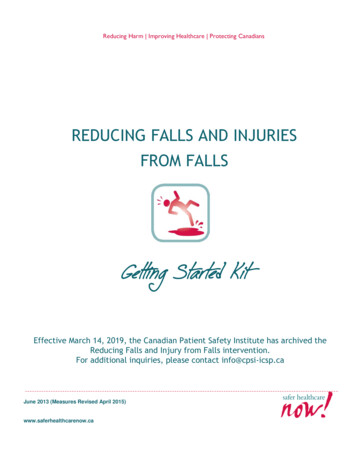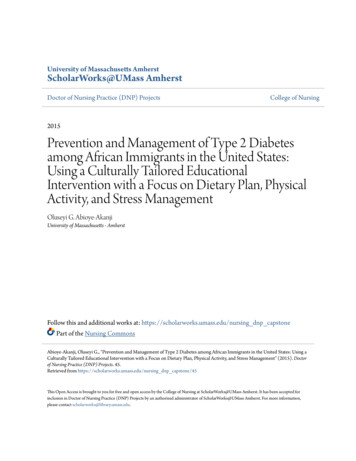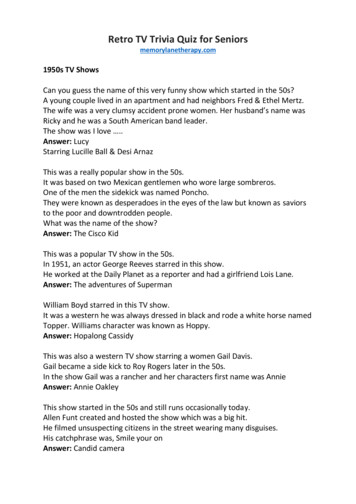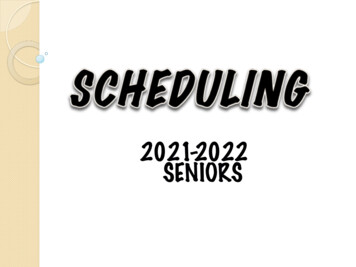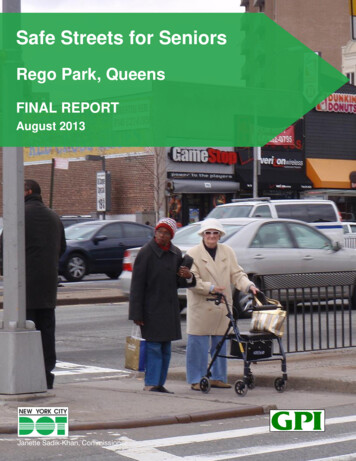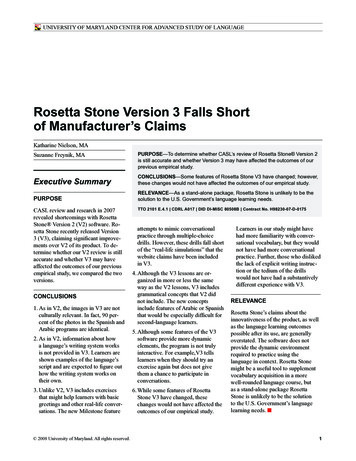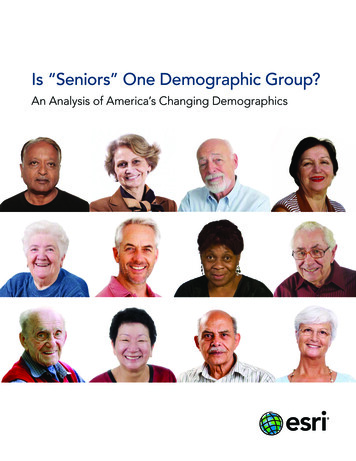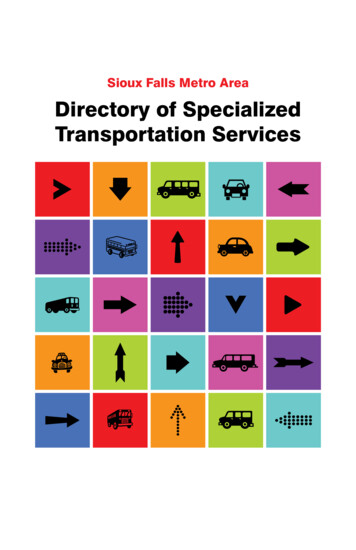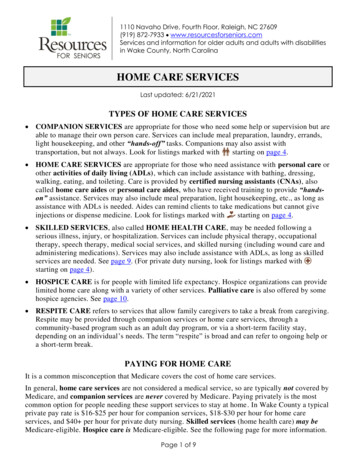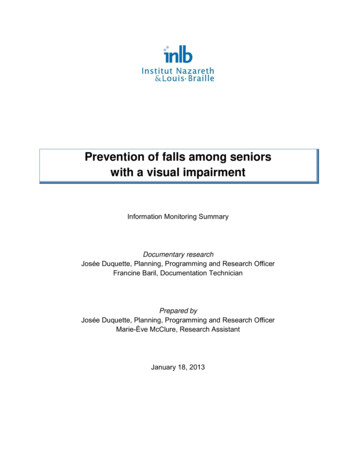
Transcription
Prevention of falls among seniorswith a visual impairmentInformation Monitoring SummaryDocumentary researchJosée Duquette, Planning, Programming and Research OfficerFrancine Baril, Documentation TechnicianPrepared byJosée Duquette, Planning, Programming and Research OfficerMarie-Ève McClure, Research AssistantJanuary 18, 2013
Notice to readersThe information in the following pages is not intended to be an exhaustive review of theliterature. The goal was to make directly relevant selected information more readilyavailable. Accordingly, not all articles or documents dealing with the topic have beenreviewed.Authorization to reproduceThis document and the accompanying material may be reproduced for clinical, teachingor research purposes with the prior written consent of the Institut Nazareth et LouisBraille. Modifying this document and the accompanying material in any way whatsoeveris strictly prohibited. Any reproduction in whole or in part of this document and theaccompanying material for commercial purposes is strictly prohibited. 2013 Institut Nazareth et Louis-Braille
Prevention of falls among seniorswith a visual impairmentSummaryFalls result from an interaction of multiple intrinsic (individual condition andbehaviour) and extrinsic (environment) risk factors. Many, however, could becorrected or at least mitigated. Recommendations in fall prevention mattersupport personalized multifactorial interventions aimed minimally at 1. improvingmotor activity capabilities (strength, balance and gait), 2. improving safety in thehome environment, 3. reducing medication consumption and limiting use ofpsychotropic drugs, 4. and acting on at least one of the four additional riskfactors, among which are visual disorders.Seniors who have a visual trouble or deficit are 1.5-2.0 times more likely to fallthan those who do not. Visual impairment (VI) adversely affects perception ofenvironmental elements that can cause a fall. By also interfering with perceptionand use of static and dynamic visual information, it compromises balance andposture and increases risk of falls.Seniors with VI are generally less active, which may cause a reduction infunctional abilities and, in return, a sensory loss. This closed loop may causedegradation in efficiency of the anticipatory process and postural regulation, areduction of dynamic balance and increased risk of falls.In addition, fear of falling, common in older persons with VI, is a significantpredictor of a future fall. It can lead to a reduction in self-confidence and activitiesand, consequently, deterioration in physical capabilities and quality of life.Frontline vision impairment screening is recommended, followed by guiding thesenior with a suspected visual impairment toward specialized services of an eyecare or vision rehabilitation professional. Rehabilitation can help improve severalmodifiable risk factors, such as motor activity capabilities (balance, muscularstrength and gait); visual capabilities; functional capabilities; life habitsaccomplishment (travel, etc.); cognitive capabilities; behaviour capabilities (e.g.affect, safety behaviour, etc.); physical environment safety, such as at home(actions regarding architectural barriers).1
Prevention of falls among seniorswith a visual impairmentThe prevalence of falls among seniors is high and represents a public healthproblem. Among risk of falls factors are vision disorders. This brought us toascertain the extent of knowledge and current evidence on the effectiveness ofprevention measures from a visual point of view and on the impact ofrehabilitation on reducing falls among older adults with visual impairments.To establish a better global perspective, risk factors for falls for seniors areaddressed first, followed by visual impairment (VI) as a specific factor, andrecommended actions.1. Risk factors and fall consequences for seniorsAccording to various literature reviews, approximately 30% of individuals aged 65and older fall every year [21]. Among those aged 80 and over, the risk increasesto 45% [56]. Most falls result from the combination of intrinsic (person-specific)and extrinsic (environmental) risk factors.a. Intrinsic factorsA number of recent literature reviews, including that of Dionyssiotis (2012) andGagnon and Lafrance (2011), draw up an exhaustive list of intrinsic risk factorsfor falls, among which are the following [15, 21]:SociodemographicAge – The prevalence of falls increases with age.Sex – Among seniors, women fall more frequently than men and are moresusceptible to fracture.History of previous fall.Health ConditionMedical Condition – Vascular disease, chronic obstructive pulmonarydisease, depression and arthritis increase risk of falls by 32% each.Medication – Due to drug interactions and side effects, risk increasessignificantly if more than four drugs are consumed, regardless of theirtype.Foot problems – Calluses or deformity of the big toe, ulcers, pain withwalking, etc.Dizziness.2
Sense and perception capabilitiesVisual deficits (acuity, color and depth perception, sensitivity to glare, etc.) –Multiple visual functions are needed to travel safely (binocular vision, darkadaptation, depth perception, glare tolerance, contrast sensitivity andperipheral vision) [16]. Vision is important for maintaining posture and fororientation in space [16]. It is one of the four sensory mechanisms thatdetect balance disruptions, in addition to the vestibular function, tactilesensation in the feet and proprioception (perception of the position of ajoint) in the lower limbs and neck [27]. But the ability to use static anddynamic visual information changes systematically in older adults, whichimpairs their balance and posture and increases risk of falls [39].Sensory deficits in the feet.Motor activity capabilitiesLoss of strength in the lower limbs – It negatively affects the ability toclimb stairs, recover from imbalance, cross a street quickly.Impairment of gait and balance – It is caused by a decrease inproprioception; postural reflexes; muscle tone, strength (10% loss perdecade after age 30), power (30% loss per decade after age 30) andendurance, etc. Harwood (2001) reports that postural control dependsmore on vision in older adults than in younger people.Decrease in grip strength.Intellectual and behaviour capabilitiesCognitive problems – Impaired memory is a risk factors for falls for peopleover 75. Among those living in institutions, the presence of dementiadoubles the risk of falls. The ability to control movement while performinga cognitive task asking to process information from several sourcesrequires the sharing of cognitive resources and may result in reducedperformance [43]. For example, as illustrated by Teasdale and Simoneau(2001), cited by Melton et al. (2011), talking on the phone while ascendingor descending a staircase necessitates the allocation of resources to thetask of conversation; this may lead to a reduction of the resourcesrequired to perform the walking movements. Moreover, the reduction ofcognitive abilities causes a reduction of the useful visual field, which iscorrelated with an increase in accidents when driving or walking [43].Depression – Increases risk of falls of by 32%.Fear of falling – Fear of falling can result from a fall; according to thestudies, up to 70% of people who have fallen may have felt this fear.Anticipatory anxiety may also occur in those who have never fallen. In3
three prospective studies reported by Dionyssiotis (2012), fear of falling isa significant predictor of future falls. It can lead to a reduction in selfconfidence and activities and, consequently, a deterioration of physicalabilities and quality of life. Up to 50% of people who are afraid of fallingrestrict some or all of their social or physical activities due to this fear [58].Risk Behaviours – No use of walking aid when required, etc.Lifestyle – Alcohol consumption, physical inactivity, malnutrition, etc.Daily activitiesDecreased functional abilities.b. Extrinsic factorsExtrinsic (environmental) factors are those that can be prevented or controlled.Many can cause the individual to slip, trip or misstep [15, 21]:The condition of walking surfaces – Floor, stairs or sidewalk that areslippery, crowded, uneven, with doorsill, etc;Lighting – Insufficient or inappropriately oriented; glare, etc.;Presence of obstacles;Support structures – No bathroom grab bar, staircase railing, etc.;Equipment and accessories – Unsafe or in poor condition;Shoes – High or thin heels, insufficient foot support, slippery sole, etc.It is not only important to identify intrinsic and extrinsic risk factors, but also toassess their possible interactions. According to the Dionyssiotis (2012) literaturereview, the fall rate among seniors who have 1 or 2 risk factors is 27%, and risesto 78% when 4 or more factors are present.c. Consequences of a fallFor many seniors, falling triggers or aggravates a loss of independence andmobility. Fracture is one of the most serious consequences. According to aliterature review published in 2009 by the National Public Health Institute ofQuebec, among older adults who survive a hip fracture, half undergo residualloss of functional abilities; institutionalization becomes necessary in 13-20% ofcases and about one-fifth die in less than 6 months [2].Ivers et al. (2000) conducted a study with 911 cases and 910 controls, all aged60 and over. Subjects with visual acuity less than 20/60 (6/18) were 1.5 timesmore likely to suffer a hip fracture than those who had good vision. This relativerisk increased to 2.4 when the visual acuity was less than 20/100 (6/30). Poorvisual acuity or depth perception was particularly associated with hip fractures,4
accounting for 40% of the population fraction attributable of hip fracture risk(proportion of cases that would not occur if these factors were eliminated) [33].Furthermore, in a study of Grue et al. (2009), among 544 older adults with hipfractures, 15.4% had a visual impairment and 30% had visual and hearingimpairments [26].A fall can also lead to fear of falling, loss of autonomy and depression [56], whichare all risk factors for falls.2. Visual impairment, a risk factor for falls for seniorsa. The visual problem-falls associationFrom 2-10% of individuals aged 65 to 74 have visual problems; after age 75, theprevalence increases dramatically to 12-20% [21]. Multiple conditions associatedwith aging and visual impairment make this segment of the population especiallyvulnerable to falls and their consequences.The presence of low visual acuity, although its definition varies according tostudies, is one of the main risk factors for falls for seniors [39, 51, 56], makingthem 1.5 to 2.0 times more likely to fall [21, 27]. The Harwood literature review(2001) shows an association between visual function measures (acuity andcontrast sensitivity) and body sway, which is strongly associated with fall risk.Moreover, visual acuity less than 6/9 and a decrease in contrast sensitivity arerisk factors for multiple falls [32]. Impaired depth perception [27] or visual field [4]also increases fall risk. Decreased contrast sensitivity is associated with posturalinstability and a change in gait, while visual field loss influences gait strategyduring tasks presenting a high risk of falling, such as obstacle crossing [14, 55].The association between poor vision and falls was shown to be valid as much forpeople living in the community as in an institution, and for those who had fallen inthe past [27]. According to Harwood (2001), the causal link has been proven; it isclear that risk of falls increases with worse vision.Other studies support the predisposing role of VI in risk of falls for seniors, butrather in a multifactorial dimension. For example, research conducted with olderwomen found that when the reduction of visual acuity is considered alone, it doesnot contribute significantly to a fall rate increase [35]. However, older women whohave both visual and hearing impairments are four times more likely to fall thantheir counterparts without sensory impairment (relative risk). This is probably dueto their inability to compensate through auditory information for the lack of visualinformation on body posture and the environment. The relative risk of fallingincreases to 29.4 when a balance problem is added to the dual sensoryimpairment [35].5
A study by Lamoureux et al. (2010) compared, in a visually impaired olderpopulation, a group of people who had fallen during the previous year to a groupof non-fallers [37]. None of the visual factors (visual function, duration and maincause of visual impairment) was independently associated with a higherincidence of falls. However, fallers were less likely to engage in vigorous physicalactivity and experienced greater difficulties in carrying out their daily activities.The authors conclude that in the presence of VI, other factors, such asparticipation in physical activity, may be more significant in assessing risk of falls.These results are consistent with evidence showing that a decrease in musclestrength increases risk of falls among older adults with VI [14, 51].In addition, seniors with VI more often have secondary conditions orcomorbidities that may increase risk of falls than for those without sensoryimpairments. For example, in a study by the National Center for Health Statistics(1994) cited by Crews and Campbell (2004), seniors with VI were significantlymore likely to report their health as fair or poor, or to have diabetes, a coronaryheart disease, arthritis, high blood pressure or a history of stroke. They were alsomore likely to feel depressed and often experienced functional disabilities [9]. Forexample, they were about three times more likely to report difficulties intransferring from bed or chair, walking, going outside or preparing a meal. Butthis decrease in functional ability and in performing activities of daily living canbring about
Cognitive problems – Impaired memory is a risk factors for falls for people over 75. Among those living in institutions, the presence of dementia doubles the risk of falls. The ability to control movement while performing a cognitive task asking to process information from several sources requires the sharing of cognitive resources and may result in reduced performance [43]. For example, as .
